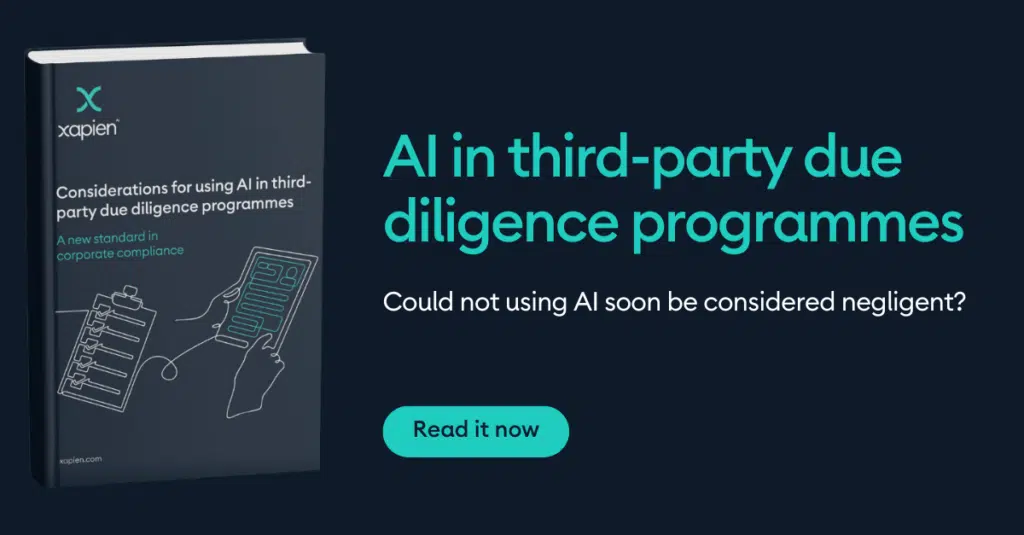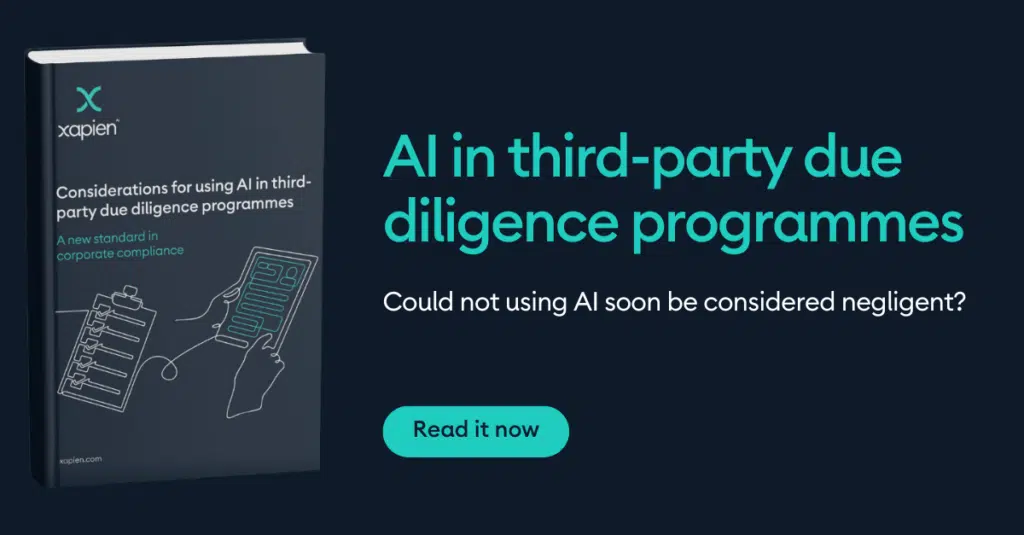
Third party due diligence:
How AI is redefining adequate compliance programmes

In today’s interconnected world, businesses heavily rely on third parties to drive operations, expand markets, and stay competitive. However, these partnerships carry significant risks. From bribery and corruption to ESG violations and geopolitical issues, the risks tied to third-party relationships are both diverse and complex. Compliance teams manage these risks through systems, processes, and tools that form part of a company’s broader compliance programme. Regulators worldwide, including the U.S. Department of Justice (DOJ), emphasise the importance of third-party risk management as a key component of corporate compliance. They frequently assess whether companies have effective mechanisms to identify, evaluate, and mitigate risks arising from third-party relationships during investigations or audits. In this blog, we discuss why corporate compliance programmes must evolve with technology to remain adequate and effective.
What are corporate compliance programmes?
Corporate compliance programmes are frameworks, processes, and tools that companies use to ensure they are following legal and regulatory requirements. Third-party risk management is part of this programme to manage the risks associated with third parties, such as vendors, suppliers, contractors, or other business partners. These processes identify, assess, and mitigate risks that third parties might pose to the organisation, particularly in areas such as bribery, corruption, fraud, money laundering, and other unethical practices. Compliance programmes within corporations also ensure compliance with laws like the UK Bribery Act or the U.S. Foreign Corrupt Practices Act (FCPA), which requires proactive measures to prevent unethical behaviour by third parties.
Regulatory expectations for compliance programmes
A strong corporate compliance programme isn’t just good practice—it’s a legal requirement. The UK Bribery Act’s Section 7 makes it clear that it’s a criminal offence for companies to lack adequate measures to prevent criminal acts. Similarly, U.S. federal guidelines focus on the effectiveness of compliance programmes both at the time of an offence and in response to it. The emphasis in both cases? Proactive prevention.
Both the UK Bribery Act and the U.S. The Justice Department Manual underscores the importance of maintaining robust programmes to prevent criminal behaviour. However, these aren’t static requirements. Evolving risks and technological advancements mean corporate compliance programmes must continuously adapt to them.
The definition of an adequate system or procedure isn’t static—it evolves with technological advancements. Outdated due diligence programmes can miss critical Anti-Bribery and Corruption (ABAC) threats, leaving corporations and individuals vulnerable to prosecution and regulatory action. Failing to modernise these programmes risks not only legal consequences but also significant reputational damage.

Bridging corporate compliance programmes and third-party risk management
Corporate compliance programmes and third-party risk management (TPRM) are deeply interconnected, with the latter serving as a critical component of the broader compliance framework. While compliance programmes aim to ensure adherence to laws and regulations, TPRM focuses specifically on identifying and mitigating risks from associations with third parties. In today’s interconnected global economy, the two must operate in alignment to protect a company’s reputation and bottom line.
Third parties—such as vendors, suppliers, contractors, and other business partners—often play indispensable roles in an organisation’s operations. However, they also bring inherent risks, ranging from non-compliance with anti-corruption laws to cybersecurity vulnerabilities and ESG violations. Corporate compliance programmes, when equipped with robust TPRM processes, can address these challenges by:
- Identifying risks early: Leveraging technology for comprehensive third-party due diligence to uncover hidden risks in supply chains or partnerships from the start.
- Tailored strategies: Implementing a risk-based approach to third-party due diligence to apply the right controls that align with regulatory requirements.
- Ensuring accountability: Establishing monitoring and reporting mechanisms to ensure third parties adhere to agreed-upon standards and laws.
Without a well-integrated approach, compliance programmes and TPRM processes can work at cross-purposes, resulting in inefficiencies, missed risks, or regulatory breaches. For instance, outdated compliance processes may fail to capture emerging risks posed by geopolitical shifts or the rise of prescriptive laws on human rights and environmental responsibility. In contrast, a fully integrated system that marries TPRM with broader compliance efforts ensures alignment across all levels of third-party engagement.
Where third-party due diligence falls short today
In the past, compliance teams relied on manual and localised processes to assess third parties. This included sending detailed questionnaires, consulting with local business chambers and trade associations, and manually searching public records, including court filings, regulatory announcements, trade registries, and media archives.
These processes were manual, slow, and less standardised. The introduction of large-scale screening databases then marked a significant change in how companies approached third-party risk management as part of their corporate compliance programmes. However, compliance processes and technologies built in the 1990s are no longer sufficient to protect against today’s risk landscape.
In addition to the continued pervasiveness of bribery and corruption, today’s risks are driven by geopolitics, globalised supply chains, prescriptive human rights laws, and ESG factors. This broader risk landscape is both nuanced and continually evolving, and can’t be captured in static, structured databases.
Why technology is changing what’s considered adequate
With advances in AI technology and machine learning, corporate compliance is undergoing a seismic shift. Unlike traditional screening processes, AI tools allow for third-party due diligence at scale. By automating manual screening and web searches, AI reduces the time compliance teams spend gathering and analysing information about third parties.
As expectations around corporate compliance grow, the failure to adopt modern tools like AI could soon be viewed as negligence. Regulatory agencies and stakeholders increasingly view outdated systems as inadequate in the face of available technology. Modernising compliance isn’t just about staying ahead of regulatory requirements but protecting a corporation’s reputation and financial stability. Integrating AI into third-party due diligence is no longer a question of “if,” but “when.”

Monthly learnings and insights to your inbox
Xapien streamlines due diligence
Xapien's AI-powered research and due diligence tool goes faster than manual research and beyond traditional database checks. Fill in the form to the right to book in a 30 minute live demonstration.